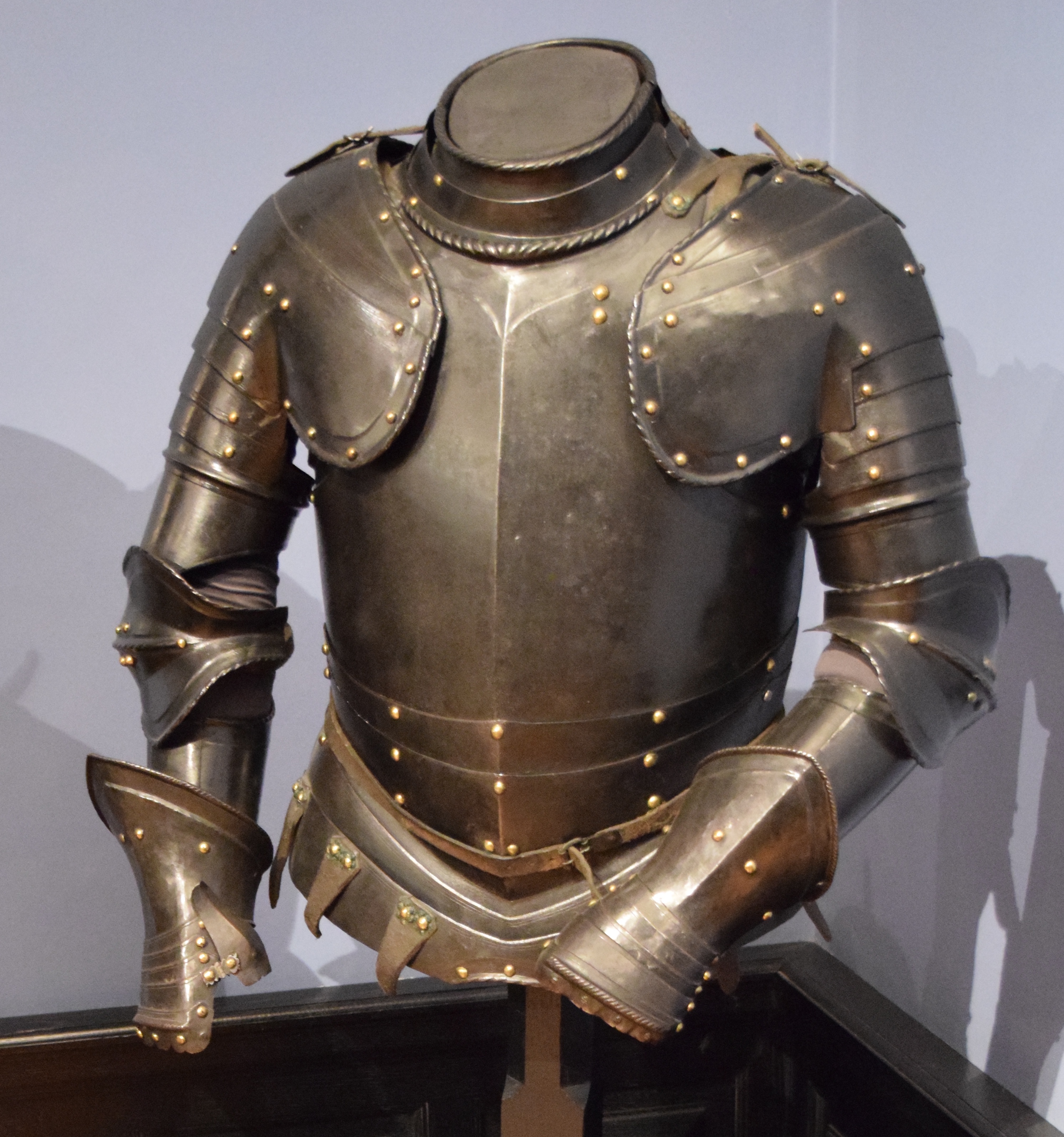




















Italian, Flemish or English Three-quarter Suit 1550-60 (original helmet c. 1600)
Composed Armour. Comprising a breastplate, backplate, morion(when acquired), close helmet, gorget, 2 arms and 2 knee length tassets. The armour is composed, possibly from items from a single armoury or collection (the close helmet was added later from a different source) - at a glance they form an armour but on close inspection the arms do not match and the tasssets are not a pair. The armour retains much black paint finish on all parts. The breast, back, tassets and arms date from 1550-60. The Morion most closely resembles those from c. 1600. The close helmet is also from 1550-70.
The breast and backplates fit well together and have similar roped edges. Both are rough from the hammer. they appear to have been originally part of the same armour. The Breastplate has heavily roped borders at the neck and arms. the armholes are formed by a pair of sliding gussets. The breast has the 2 mounting holes used for attachment of a lance rest, so it was originally designed for use by heavy cavalry. Breastplate of mild peascod form with a single lame at the waist. Upper portion of the breast decorated with 2 raised volutes. The gorget is of simple 2 piece form with rolled edges at the neck and around the lower border, possibly 17th century, the style of gorget is typical of pikeman's armours of the 17th c. The helmet is a simple one piece morion with high comb and narrow brim. Comb and edge of the brim roped. Backplate of simple form. Roped borders to neck and arms en suite with the breast. Most of one arm rope lacking due to corrosion. The arms are composed of pauldrons of 9 plates each designed for use either without arms, with floating elbow cops (as currently displayed) or with elbow gauntlets. The elbows are 'floaters' - not articulated to the vambrace, instead being attached to the arms by means of leather straps. They are of bracelet form with pronounced roped medial ridges. The left has a recessed border on the wing. The vambraces are designed for use with floating elbows and are formed of 2 pieces, attached by 2 hinges and secured closed by means of a pin. The left has a recessed border at the wrist, the right is plain. both have roped borders at the wrist and inside of the elbow. The tassets are formed of 9 (right) and 11 (left) plates. They are similar in design and construction, but obviously not a pair. The are secured to the fauld by 3 buckles (the left retaining all three original buckles, the right having 2 original and one replacement). Two buckles on the breastplate, the buckle on the waist belt, all rosette washers and all external leathers replaced. The replacement buckles are well-made modern copies of the original tasset buckles. The rosette washers are stamped with raised daps in each petal. They are two different sizes for larger and smaller straps.
The breasplate and tassets are very similar to II. 164 in the Royal Armouries (illustrated on plate LXII of European Armour in the Tower of London,arms this early with similar elbows and vambraces on the Anne de Montmercy armour in the Metropolitan Museum of Art NY). Another similar cuirass with similarly constructed pauldrons is preserved in the armoury at St. Mary's Church at Mendlesham. Another similar cuirass is preserved on Inv. Nr. A 1038, A 837 in Vienna described as Italian, c. 1545. In that case the brestplate has an additional lame at the waist and the pauldrons have turning collars, but the style is very similar. Another similar cuirass is Inv. Nr. A 406 in Vienna dated 1550/55. In this case the form is very similar with the single waist lame and similar rounded roping. The Vienna example is much nicer. Purchased with a later morion, now displayed with item number A-271 which is a close helmet of similar style that survived as a funerary achievement. Originally purchased with item number A-1-a. Now as displayed consists of item number A-1-b, item number A-1-c, item number A-1-d, item number A-1-e, item number A-1-f, item number A-1-g, item number A-1-h and item number A-271.
If you have any questions, please send them to Wade Allen
This site last updated Mon Dec 27 11:29:14 EST 2021